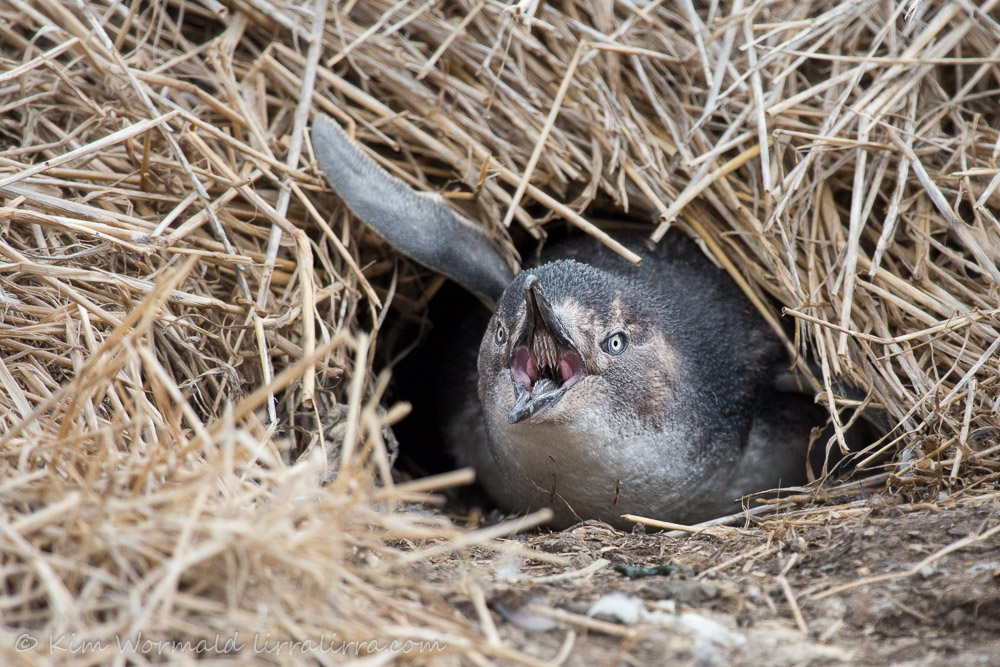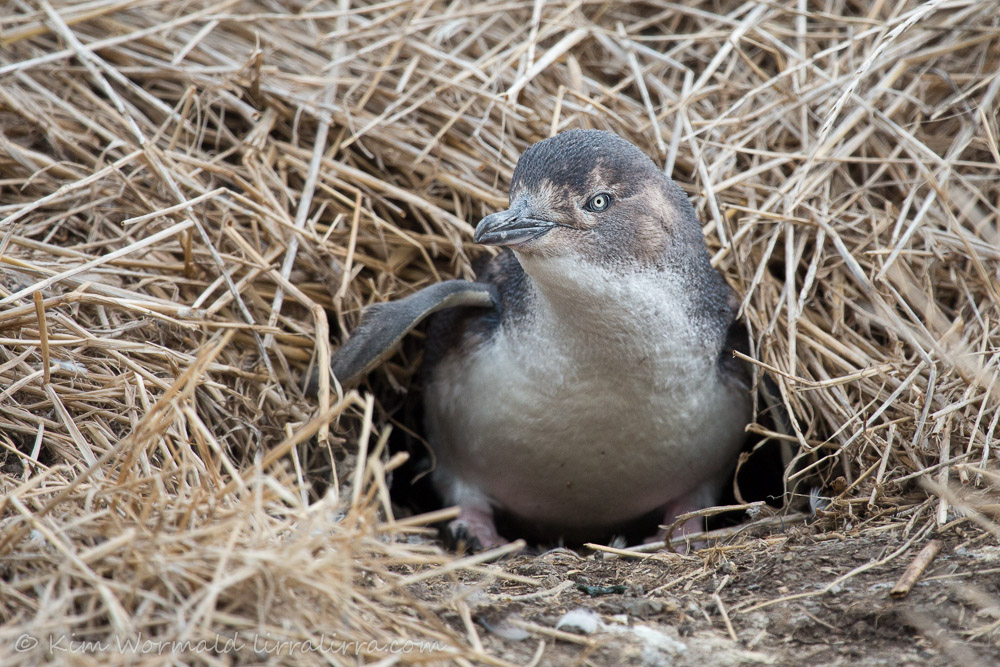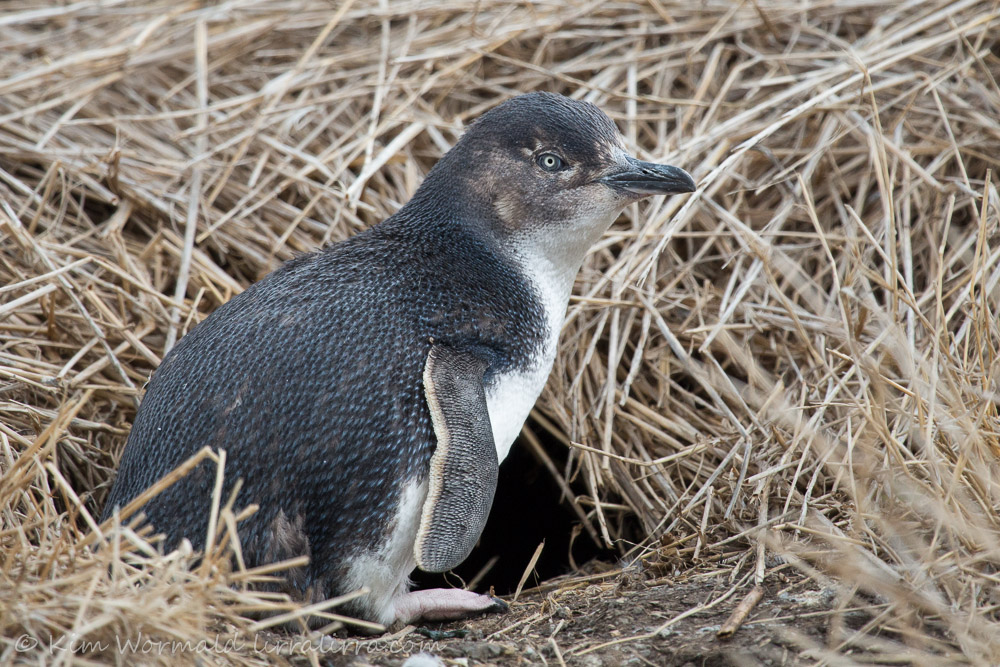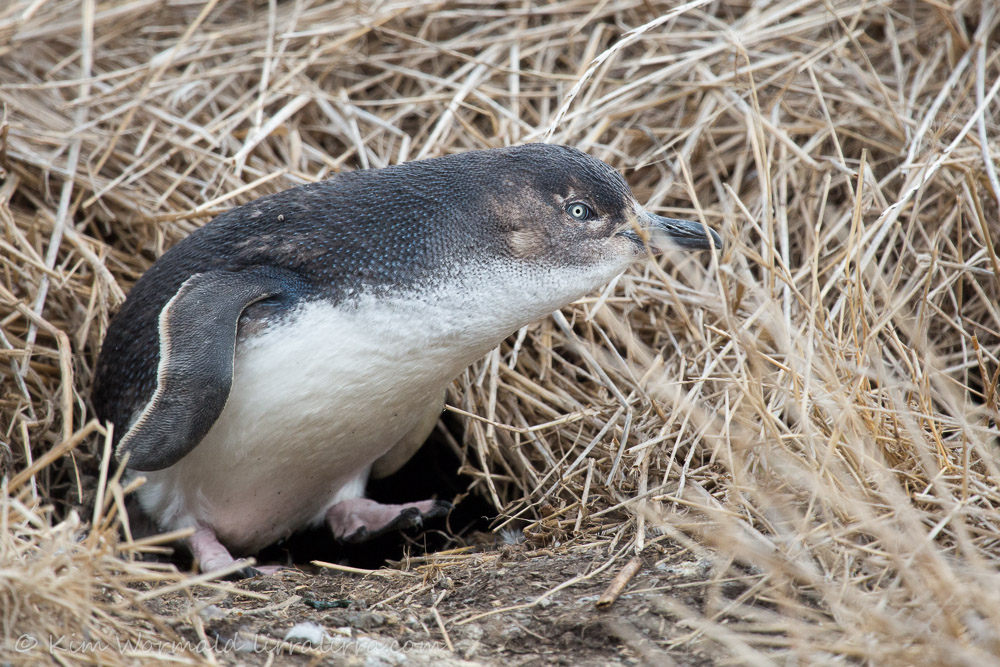It was cold and windy so off I went to The Nobbies at Phillip Island to look for Silver Gulls and raptors in flight but there wasn’t a bird to be seen except a lone Willie Wagtail that swooped across the far end of the car park and disappeared. The only bird I might get to photograph would be a Little Penguin, if one was kind enough to be hiding under the boardwalk or … or peeking out of its burrow!
 Little Penguin (Eudyptuia minor)
Little Penguin (Eudyptuia minor)
Canon 5D Mk III, 100-400mm L IS USM, 1/1600, f/5.6, ISO 1600, focal length 400mm
The boardwalk curves down and around the headland and any hint of a sea breeze makes itself well known to walkers and birds. Raptors and gulls can cope with strong winds (see Gale Force Gulls for images of amazing fliers) while Little Penguins tuck themselves away in their burrows during the day unless they are fishing out at sea. Little Penguins are about 33cm tall and are also known as Blue Penguins and Fairy Penguins. They are sleek birds with wings that are used as flippers to propel them through the water. I don’t always like the look of pale irises but I do like the eyes of Little Penguins.
 Little Penguin
Little Penguin
Canon 5D Mk III, 100-400mm L IS USM, 1/1600, f/5.6, ISO 1600, focal length 400mm
It would be easy to invent an interesting story about the image above, “Little Penguin squeals as fox/cat/snake/human gets too close to its burrow”. In fact the penguin was having a stretch and a quiet yawn. I was lucky to be looking at it through the lens and was fascinated to see the strange serrations inside its bill which must help it grip the small fish and squid that form a large part of its diet. Its wing looks very flipper-like in this image.
 Little Penguin
Little Penguin
Canon 5D Mk III, 100-400mm L IS USM, 1/1600, f/5.6, ISO 1600, focal length 400mm
Just when I thought it was about to tuck itself back into the darkness of its burrow the Little Penguin took a couple of waddling steps towards me on its little pink feet.
 Little Penguin
Little Penguin
Canon 5D Mk III, 100-400mm L IS USM, 1/1600, f/5.6, ISO 1600, focal length 400mm
Then the sweet bird emerged from its burrow and posed for a profile shot that showcases its colouring, the density of its feathers, its pink feet and strong bill. Even though the lighting was overcast the blueness of the feathers on the penguin’s back is obvious. Little Penguins are able to dive for up to one minute to depths of around 30m although most of their dives are about 2m. Their dark backs and light bellies help protect them from predators as when viewed from above they blend with the darkness of the sea beneath them and when viewed from below they merge with the lightness of the sky above.

Little Penguin
Canon 5D Mk III, 100-400mm L IS USM, 1/1600, f/5.6, ISO 1600, focal length 400mm
The image above is less flattering but I liked the determined way the penguin decided to leave its burrow and head off through the drought-stricken grass.
Several years ago I helped with some Little Penguin surveys when we carefully caught, measured and released the birds. Taking these images brought back good memories and a reminder to thank all the dedicated nature lovers out there who continue to help our wildlife in whatever ways they can.
Happy birding, Kim
PS The Equipment page has been updated to include the 5D Mark III and various other items.
It is possible to receive a weekly email informing you that lirralirra has been updated – just add your address to the ‘Subscribe to email’ box above right.
Thank you Facebook ‘likers’, button above right – much appreciated.

[…] Little Penguins have an incredible number of downy feathers, about 10,000, which is up to four times the number typical of birds of flight. The extra density provides insulation as they swim through cold waters to feed on fish and squid. They have spines in their mouths which help them grip and swallow their prey, I posted an image a while back that shows the peculiar structures inside the mouth of a Little Penguin. […]
These are marvelous images!
Thank you Mia.
Hi Kim,
What a greats pisctures, this Little Penguin is very very cute ! I wish to do him big kiss ! LOL
And bravo for you !
You’re funny Nathalie!
hello kim =))
how cute it is this little pingouin, wonderfull serie =D
thanks a lot, and happy birding
Hi Eric! It is a cute little critter, I’m glad you like it. Happy birding to you too!
How cool, to even see a penguin..It is so cute, adorable photos. Happy Birding and have a great weekend!
We’re very lucky to have them living here, not many people think of Australia and penguins in the same sentence. Have a lovely weekend Eileen.
Hi, Kim. Interesting observation on those backward facing serrations in the penguin’s mouth. It is always interesting to see penguin documentaries on the tele. They seem such characters. I also like their strong sense of community such as the way the Emperor Penguins take turns at bearing the brunt of the wind when the eggs are being incubated. Keep up the good work.
I agree with you about Emperor Penguins! I’m amazed all over again every time I see footage of them swapping the egg between them and carefully keeping it away from the ice and snow. I wonder if they’ve got the same kind of serrations in their mouths.
Such as interesting read as always Kim. Great to tie in reference to another one of your posts related to this area/topic. I particularly took note of your metadata, hoping to try some of the same with my new Olympus and big zoom lenses soon! Thanks for the info support. Cheers, lyn
I’m glad you like the link to the gale force gulls, they were amazing to watch. The metadata this week shows that I didn’t have time to get it right. I was on ISO 3200 to start with, it was very overcast but became a fraction brighter as I walked. I changed it to 1600 and took the shots, would have changed it to 1/800 and ISO 800 if I’d had a spare second. Have fun with your new Olympus!
Such pretty little waddlers. Very nice group of photos!
They are pretty little waddlers, I should have used that as the title
I have a HUGE soft spot for penguins. Any penguins. And until I went to Antarctica had only been able to indulge myself on the little penguins. And I love them still.
Thank you for the warm and fuzzy feeling this post has instilled in me. Again.
How awesome to have been to Antarctica EC. I’d love to see some of the amazing sights down there but for now it’s just the littles for me.
Hello Kim,
A beautiful set of photos of the penguins, I loved looking at them and kept hoping there would be one more and I wasn’t disappointed, your photos and articles would make a lovely book, if you felt so inclined to do so one day.
Carole.
Thanks Carole, I’m glad you weren’t disappointed! It would be fun to put another book together, a winter project maybe. We should talk to the rest of the PICC team about an island book.
Your photo’s and article to me is so interesting, mostly because as you know I have always loved going out with you to view these special little guys, unfortunately it has always been at night and never had the opportunity to see their colours, never in a million years did I think they might have pink feet or such a beautiful blue colouring . Thank you for this Kim. Dona
I love your comment Dona! It’s such fun to have shared a ‘magical mystery of birds’ with you. Next time we see them at night we’ll enjoy them even more, Kim
Thankyou Kim, I look forward to your great bird photos each week and the articles you write about the birds. Valda
Lovely to hear from you Valda. So pleased to know you enjoy the images and articles